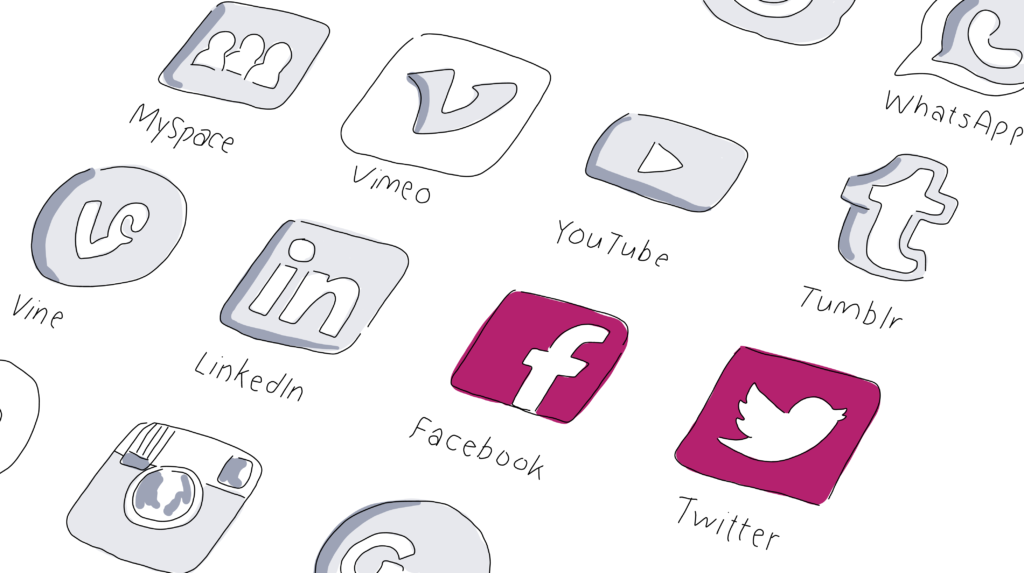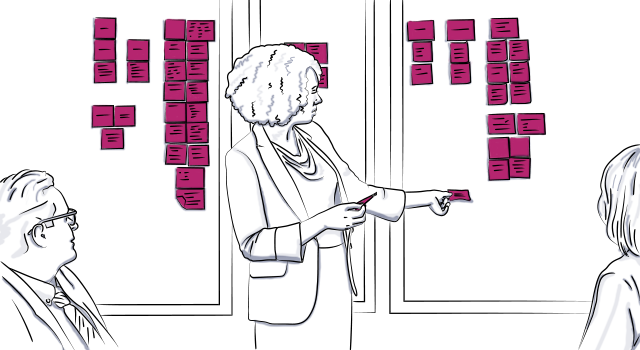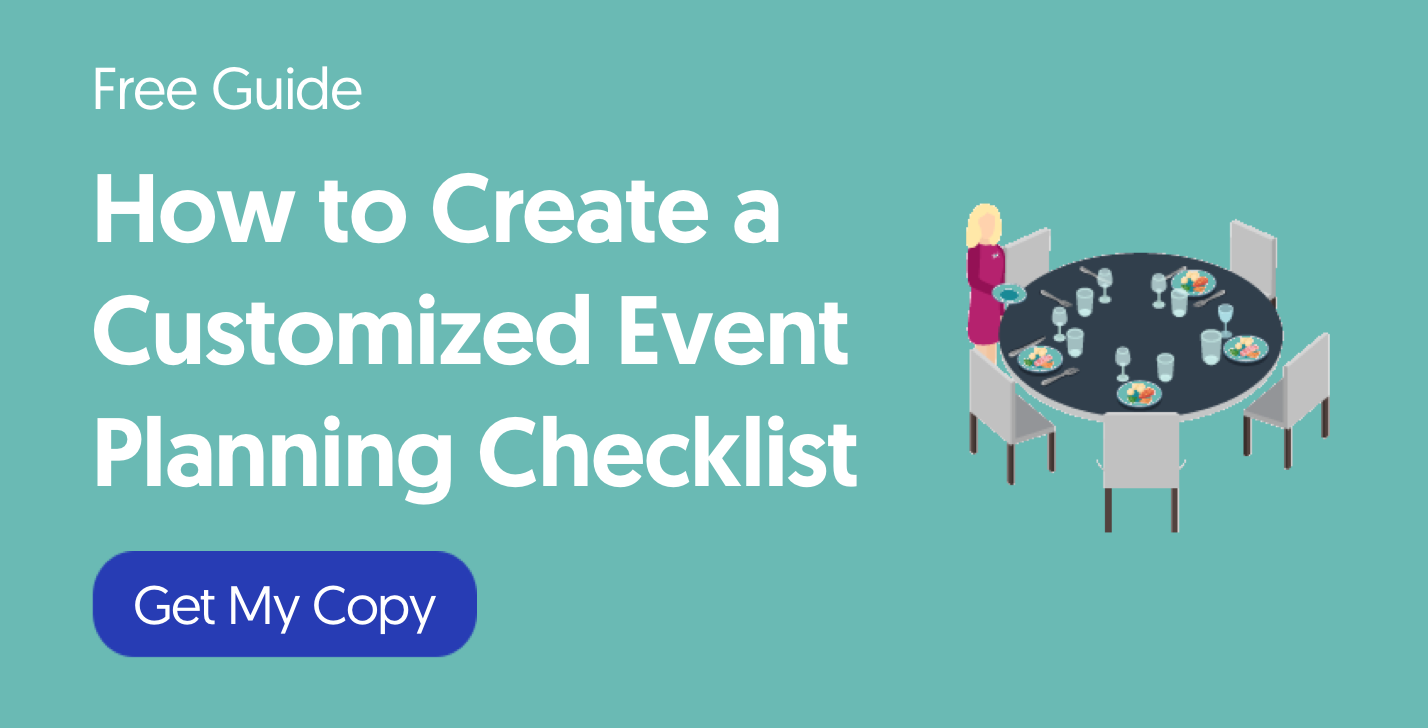
29 Tips for a Comprehensive Social Media Event Strategy
Today, having a social media strategy for events doesn’t set you apart from the crowd ” but having a GREAT one does.
Whether your event is online or IRL, B2C or B2B, there are tricks to designing an event social media strategy that gets you noticed, sells tickets, and engages attendees. Read on to learn how to post fantastic content on the right networks and harness the full power of social. Let’s go!
Social media strategies before the event:
Before the event, your social strategy prioritizes reach, connection, and anticipation. Follow these guidelines:
1. Clarify your target audience and ideal social platform before the first post
You don’t want your social efforts to reach just anybody; that’s a waste of work. If you are running a conference for in-house software developers at banks, you want to reach software developers at financial institutions. If you’re putting together a gala for donors to a museum, you want to reach (you guessed it) current and prospective donors.
The demographics of your target audience and your event give you valuable information about where to concentrate your efforts. Use these examples and tactics to help pinpoint your audience and discover their most-used social platforms:
- Discover bank software developers looking for career-related growth on LinkedIn.
- Find image-oriented museum donors on the museum’s Instagram account.
- Concentrate your audience research efforts on Facebook if your museum donor demographic is older.
- Look at engagement on all of the platforms of your company, or your client’s company. Focus your promotional efforts on the top performing social platforms.
- Research direct competitors or non-competitors going after a similar target audience: Which of their platforms generate the most engagement for them?
2. Generate buzz with hashtags
A memorable hashtag is #VeryNecessary ” and you want it consistent with your branding, too. An all-business seminar needs an informative hashtag, while an energetic event with a bit of personality demands a hashtag with a sparkle in its eyes. Follow these tips on how to create an event hashtag.
Once you’ve created your hashtag, of course you’ll use it on your social posts to encourage the kind of two-way interaction that defines social media. But your hashtag doesn’t need to confine its life to your social posts. It can build reach and community when it crops up on sponsors’ websites, digital newsletters, and even email signatures.
3. Engage influencers known to your event target audience
Research influencers who have spent time building cachet with your target audience. Tools for this abound at a variety of price points. You may want to assemble a list of 10-25 influencers, depending on the size of your audience. Then start at the bottom half of that list with influencers who may be an easier get for you. Reach out and explain who you are, what you’re looking for from them, and consider calling out the posts you’ve most enjoyed.
Don’t forget your speakers, who may be popular with some segments of your audience already. Make it easy for them to share info about your event with their contacts. Create posts or images flattering to your speaker that they will be happy to share with their network of fans.
4. Prioritize consistency
For best brand recognition, your social presence should have the same colors, logos, and tone across platforms. Log out of your brand’s account, or log into a personal account, and check what your accounts look like to visitors. Make a list of photos or information that need updating and make those changes platform-by-platform before too many posts go live.
5. Keep your posting schedule slow and steady
A barrage of sales messages is a surefire way to get people to tune you out. Provide content that interests your followers, excites them, and occasionally markets to them. Take it slow and steady, and realize that if you have an end goal like X number of ticket sales, a strategy that consists solely of bolting for that number will backfire.
6. Pique interest with teaser posts
An Instagram post of a stand-out image from last year’s event. A short time-lapse video on Facebook of the space getting readied for this weekend’s event.
Teaser posts do a few things. First, they get people excited for a known quantity. Marvel fans know all about the power of teasers. If you love the Avengers, simply seeing the A for Avengers and a date in the distant future is enough to produce real, visceral excitement.
Teaser posts also build interest among people who don’t already know they’ll love your event. As a movie’s release date approaches, Marvel doesn’t only publicize the A with the date. They release images and videos that further excite existing fans, and builds interest among new fans, too. You can do the same with your event: use teasers that appeal to existing fans and build excitement among new ones.

7. Combine owned, earned, and paid for lively engagement
- Owned social media is your company’s or client’s own Facebook, Instagram, Twitter, or LinkedIn.
- Earned social media is the exposure you garner through posting content that your followers share with others on their own.
- And don’t dismiss paid: Fully half of event planners use paid social advertising for their events.
Use social media to sell tickets to your event
Social media is an outstanding tool for increasing ticket sales, but you have to use it right. Here are a few more things to consider as you plan how to use social media to sell more tickets.
8. Have enough event info to sell tickets as soon as you announce
Jump on people’s interest and excitement for your event when those emotions are fresh. You don’t have to have all the event details hammered out yet. But at a minimum you need: your location, date and times, and ticket price. It’s ok if the dinner menu is TBD.
9. Make it easy to buy tickets
More than half of consumers ” 55 percent ” have bought something online after discovering it on social media. You want the path from social media discovery to ticket sale as short and frictionless as possible: minimal swiping, clicking, and navigating. And make sure your ticket sale solution is equally as frictionless on mobile as on desktop: Half of all internet shopping is now from a mobile device.
10. Use scarcity as a motivator to boost ticket sales
Scarcity is a big motivator. Advertise ticket scarcity on social”only five VIP tickets left, only ten front-row tickets, only one day left for early-bird pricing. Let people know that time and availability is at a minimum so they click ˜Buy Tickets Now.’
11. Give speakers or special guests a special promo code
This is a win for all parties: Your speaker/guest/entertainment gets to provide value to their network, their network enjoys a discount to an appealing event, and your event gets more exposure with its target audience.
With the code, you can also track which ticket sales come from these referrals.
Social media strategies during the event:
Though people are already connecting in person during an event, you can amplify and strengthen the connections among participants, remote participants, and event hosts.
12. Look for opportunities to livestream
Livestreaming is growing at lightning speed on Facebook and Youtube. Emarketer estimates that in 2020, people will spend an average of 92 minutes per day watching digital video, and Facebook itself says that people spend more than three times longer watching a video when it’s live than when it’s no longer live.
You can live stream the keynote, obviously, but look for other opportunities, too: post-keynote interviews? A red carpet arrivals area for VIPs?
13. Make your hashtag visible
You want your hashtag in the public consciousness at your event. It encourages people to share on social media in ways that you can track, and in ways that will build community around the event.
Photo booths are an obvious place to post your hashtag, but you’ll find plenty of opportunities to think outside the booth, too. Find photo-worthy locations and moments by taking a mental run-through of your event. Include it before and after speaker presentations to encourage anticipatory sharing and post-speaker thoughts via hashtagged posts. It doesn’t have to be in the digital world”put it on printed materials, too.
14. Use a social wall
This brings real-time visibility to the activity around your hashtag by displaying hashtagged posts: pictures, text, reactions, even questions for speakers.
You can use any projection screen along with social aggregation software like Hootsuite. Keep in mind that you may want to have someone dedicated to managing the stream during the event, approving posts before display.
Social media strategies after the event:
Keep the energy going and the community connected after the event.
15. Post event video
Turn videos into compelling content that drives further engagement. The footage can come from a professional videographer, a team-member with a smartphone, or video shared by attendees. Check out Hubspot’s psychology-based hacks for making great videos.
16. Look for event testimonials
Your social media aggregator can help you find testimonials from your attendees. Instagram captions, enthusiastic tweets, and Facebook ruminations are all great sources for first-hand responses to your events.
Use those testimonials in your advertising next time you hold the event, of course, but also post them on your feeds and tag the original poster in your thank you. They represent a not-to-be-missed opportunity for engagement with a supporter, plus an opportunity for that supporter’s engagement to become visible to their network again. According to research from SurveyMonkey, people report they are five times more likely to be influenced by their friends and family than by an online influencer they don’t know. Having a participant’s real testimonials visible to their network is incredibly valuable.
17. Elicit event attendee testimonials
Get that brief post-event survey onto your attendees’ devices directly after the event, and post a friendly reminder on social about it, too. Consider including an open-ended question at the end of the survey where people can leave feedback that you can use in testimonials.
If your survey is anonymous, you won’t have the link-back opportunities described above. Ask for feedback in the caption on a short video or Instagram post so that your testimonials can be attributed. Post a picture of the breakfast buffet, for example, with: Our favorite part of Saturday morning was the breakout session, but these waffles were a close second. What did you love?

18. Choose owned social platforms that make the most sense
Facebook has a ton of reach across industries, but you might concentrate on LinkedIn if your event has a business focus. Educational video content from your event has value on Facebook, LinkedIn, and Twitter, but be sure to post it to YouTube as well.
19. Make sharing easy (and beneficial!) for third-party platforms to earn coverage
Provide content that people want to share:
- Images are popular across platforms: Facebook posts with images receive three times as many shares as those without, and Tweets with images get shared twice as often, according to an OKDork/BuzzSumo analysis of 100 million (!) posts.
- Aim for content that produces laughter, entertainment, awe, or positive recognition about self and community.
- Don’t forget to re-promote successful content, so long as it remains relevant.
Creative ideas for social media for online events
Online events have their own set of strengths and challenges: They can be easier to host, but harder to promote. Use the following bonus tips:
20. Give people online reminders
You have a tech-savvy audience; engage them where they are! Ask them to submit questions for speakers or teachers. Remind them if they need special tools for the event. Consider organizing a date and time they can test out their online attendance tools with a dry run.
21. Use video in the run-up
Post video of the rehearsals or prep for the online event. Have speakers submit a short video introducing themselves and their topics.
22. Use your video wisely after the event
If the event was live-streamed, you have a goldmine of video. If the event was a webinar, capture the screen you’re using during the class. Afterward, you can create promo materials for the next event, educational materials (on YouTube or paid learning platforms), or clips for social.
Unique social media strategies for B2B events
Many of the same tips apply to B2B and B2C events. Video is always engaging, for example. You’ll still want to figure out where your tribe hangs out online and IRL, and you’ll want to sleuth out what they want from your event. Do they want to stay on the cutting edge of the agricultural regulation industry? Are they hoping to network with other mortgage specialists? Let that inform your strategy.
Also consider the following strategies that are particularly helpful for marketing B2B events via social media.
23. Create a targeted social strategy for your keynote speaker
Promoting speakers”especially keynote speakers”is especially crucial for B2B events. Business speakers likely have networks interested in them and the topic, so leverage that. Provide promo codes for your speaker to share, and create event-branded content that is flattering to them, such as a relevant quote over an engaging picture.
24. During the event, post JUST before and during transition times
This is when attendees are scrolling!
25. Respond to stand-out moments during the event
Stay active on social and encourage your attendees to share during the event by updating live. Amplify your reach with a social wall.
26. Encourage vendors to post (lightly) about any giveaways
Build buzz in the vendor hall by encouraging them to post a little about any freebies, promos, or giveaways. Make sure they have the schedule of the entire event so they can schedule their posts to hit just before exhibit hall time.

Essential social media event marketing trends to know
Social media isn’t the flash in the pan that some thought it might be a decade ago. Instead, it’s deeply integrated into the daily life of many consumers, businesses, and events.
27. Use augmented reality
Give attendees an advance tour of one of the main event spaces, or a view of the stunning atrium. Social Tables’ photorealistic 3D rendering takes viewers on a video tour, even before you’re able to collect the video.
28. Allocate your social marketing time, energy, and money strategically
According to EventManagerBlog, 52 percent of event planners engage on social media several times a day. Choose whatever platforms make sense for your event and the size of your team, and commit to them.
The key is to set a level of engagement you can keep; don’t go all-out and then stop for a while. It’s a marathon, not HIIT, and consistency is key. It looks unprofessional at best, and is off-putting at worst, for an event organizer to respond immediately to some posts and then appear to ignore others for ages. Use event management software, such as Social Tables, to help keep your team’s social posting on track. Better to have sustained engagement on one platform where your audience is active, than spotty engagement on several platforms.
29. Find ways to personalize your posts ” it’s increasingly expected
For example, at a tech industry conference, you will likely have both coders and marketers in attendance. Make sure you speak to both groups.
Now you’re ready to implement your comprehensive social media strategy!
Are you inspired to improve your event social media returns? Take it further: Get some great tips on using social media and other channels to market a keynote speaker. And for a deeper dive on using social media at your next event, download our eBook, 30 Social Media Tips & Tricks to Engage Attendees.
Want to learn more about event social media strategy?
The most successful social media event announcements typically involve a concerted effort across social media platforms. Change profile pictures, create hashtags, sell tickets directly through Facebook, and do everything you can to make a splash that will catch the attention of your audience. Social media contests, influencers, and carefully curated content will contribute to a successful announcement.
Social media is crucial for event promotion in today’s world. Hashtags, Facebook event pages, Instagram comment sections, and social media contests all become community spaces where your audience will do the legwork of building excitement. Use as many tools as you can, and if possible craft a dedicated promotion strategy for each social platform – what works on a Facebook event page will not be as successful on Twitter.

